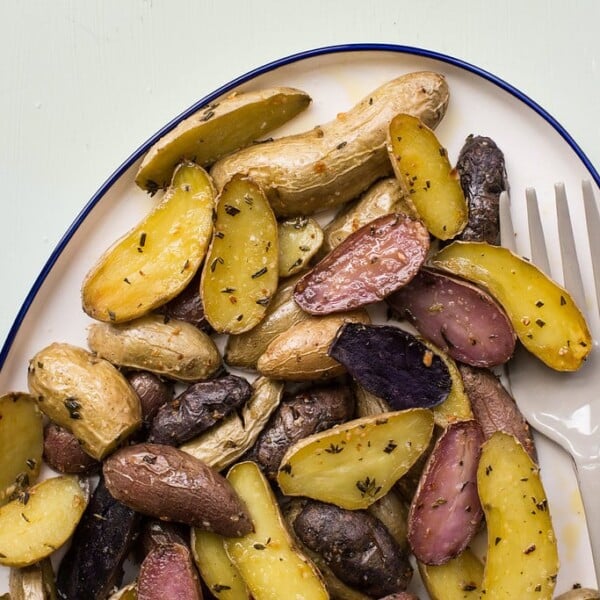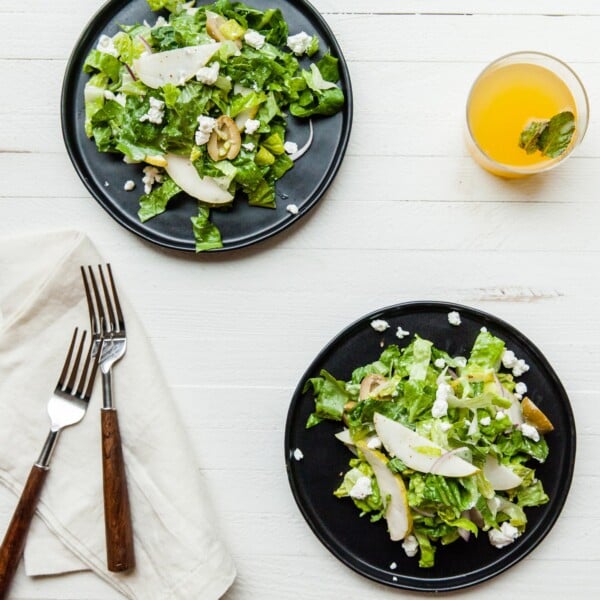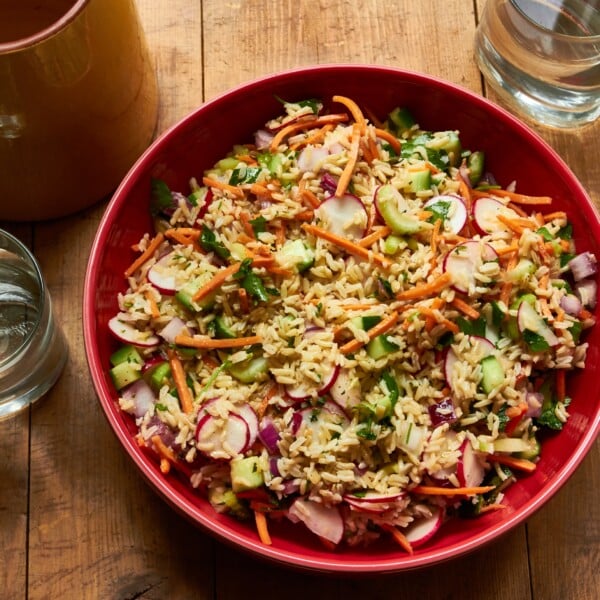How to Cook Duck Breast
on Apr 29, 2024, Updated May 20, 2024
This post may contain affiliate links. Please read our disclosure policy.
Cooking duck breast at home is easy and impressive (and a quick and easy sour cherry sauce turns it into a restaurant-level meal!).

Many of us have only had duck in restaurants, and that’s a shame because cooking duck breasts at home is not only easy but also a surefire way to impress. You can find duck breasts in many well-stocked supermarkets and certainly at any good butcher counter.
Duck skin can be wonderful — crispy and crackling, full of flavor — or it can be flabby and unappealing. This method of cooking duck breasts in a skillet on the stove ensures appealing, crispy skin, which is such a wonderful contrast to the juicy, flavorful meat.
By signing up, you agree to our Privacy Policy.
The flavor of duck meat is very rich, and so the meat itself needs very little seasoning. You can certainly sauce your finished duck breasts for a more sophisticated dish, but a simply cooked duck breast is plenty full of flavor. This is not to say you can’t season your duck with various spices — just give a plain duck breast a go first to enjoy the deep flavor of the meat on its own. And you definitely will want to give the variation with the easy sour cherry sauce a try. You can make the 3-ingredient sauce in the few minutes the duck breasts are resting after they’re removed from the pan!
Serve duck breast with roasted potatoes or mashed potatoes and a simple salad.
What's In This Post?
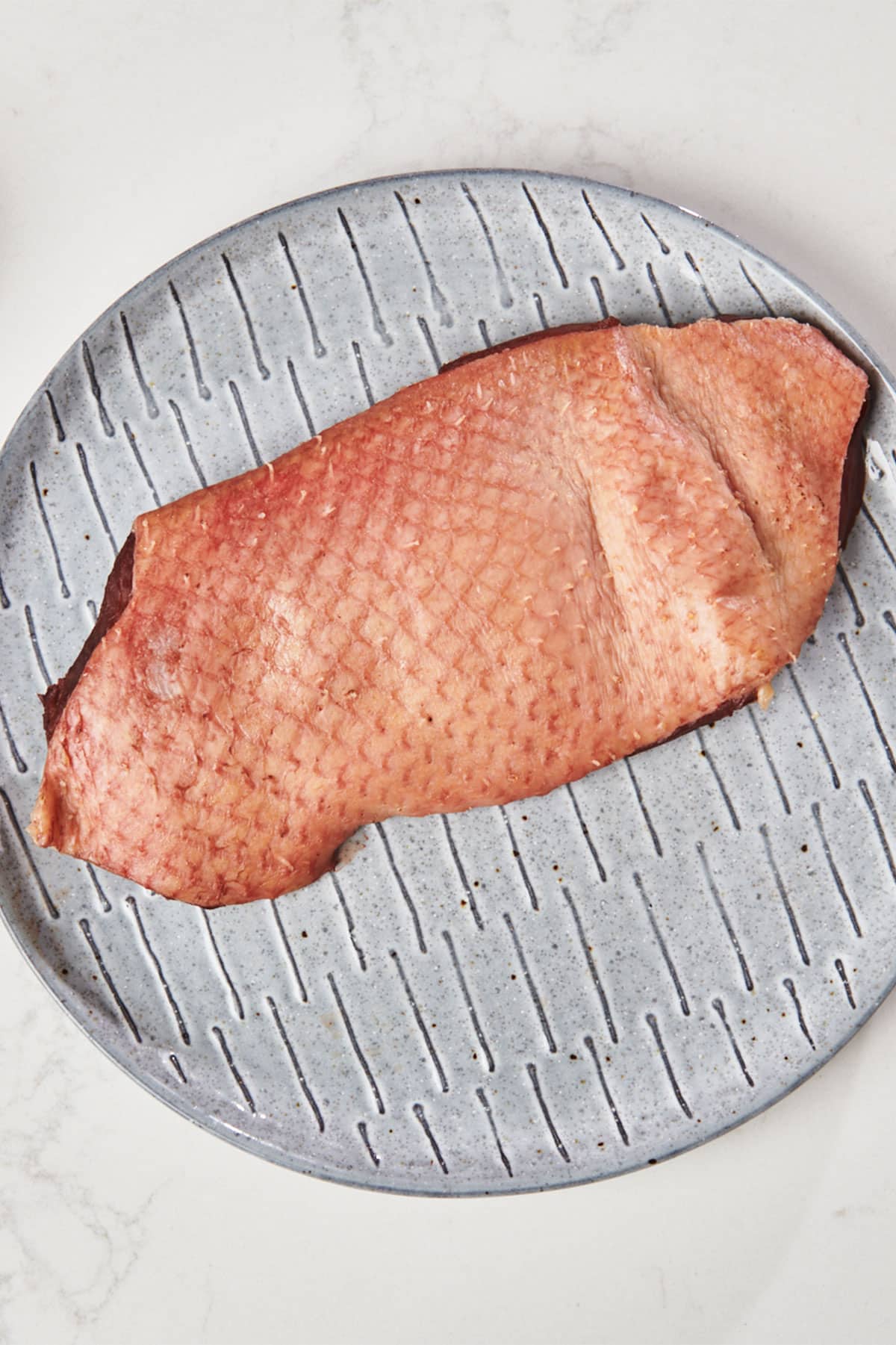
How to Cook Duck Breast: Cooking duck breast at home is easy and impressive (and an optional quick and easy sour cherry sauce turns it into a restaurant-level meal!)
FAQs
Depending on the variety of duck, an entire breast can weigh anywhere from 12 to 20 ounces. You’re most likely to find whole duck breasts in the 12-ounce range, meaning each breast will weigh about 6 ounces, which is a very good portion size for one person.
Duck breast meat is flavorful and firm, and most people agree that it is at its best when cooked to medium rare, which is 130 on an instant-read thermometer. The FDA recommends that all poultry be cooked to at least 160 degrees, but similar to a good steak, most diners enjoy it medium to medium-rare.
The total time it takes to cook the average-sized duck breast is about 14 to 17 minutes. You should cook the duck breast longer on the skin side than the meat side to achieve the perfect crispy skin and the ideal medium to medium-rare interior.
Scoring Duck Breast Skin

Scoring (or cutting into or cross-hatching) the skin of duck breasts allows it to cook up nice and crispy, with none of that unpleasant chewiness. This is because cutting into the skin allows the fat to render more easily. Rendering means that the skin is slowly heated, which encourages the fat to melt and any water to evaporate, resulting in crisp skin.
Kitchen Smarts
With a sharp knife, trim off any excess or overhanging skin from the edges of the duck breast. It’s fine if the skin ends up smaller than the surface of the top of the duck breast. A bit less skin is preferable to too much skin when searing or sautéing duck breasts.
How to Cook Duck Breasts
- Score the duck breast: Use your knife to score the skin of each duck breast, with each cut about 1/2 inch apart, creating a diamond pattern. Do not cut through the fat into the flesh, stop once you’ve cut through the skin into the layer of fat beneath. Season the duck on both sides with salt and pepper.

- Cook the skin side: Place the duck skin side down into a cold skillet. Place the skillet over medium heat. Cook, without moving the duck breasts, until much of the fat has rendered out, and the skin is crispy and browned. This will take about 10 to 12 minutes.
- Remove the fat: After about 5 minutes, pour off the rendered fat from the pan. The breasts will shrink up a bit as they cook. Watch that the heat doesn’t get too high — you want the skin to brown slowly and consistently.
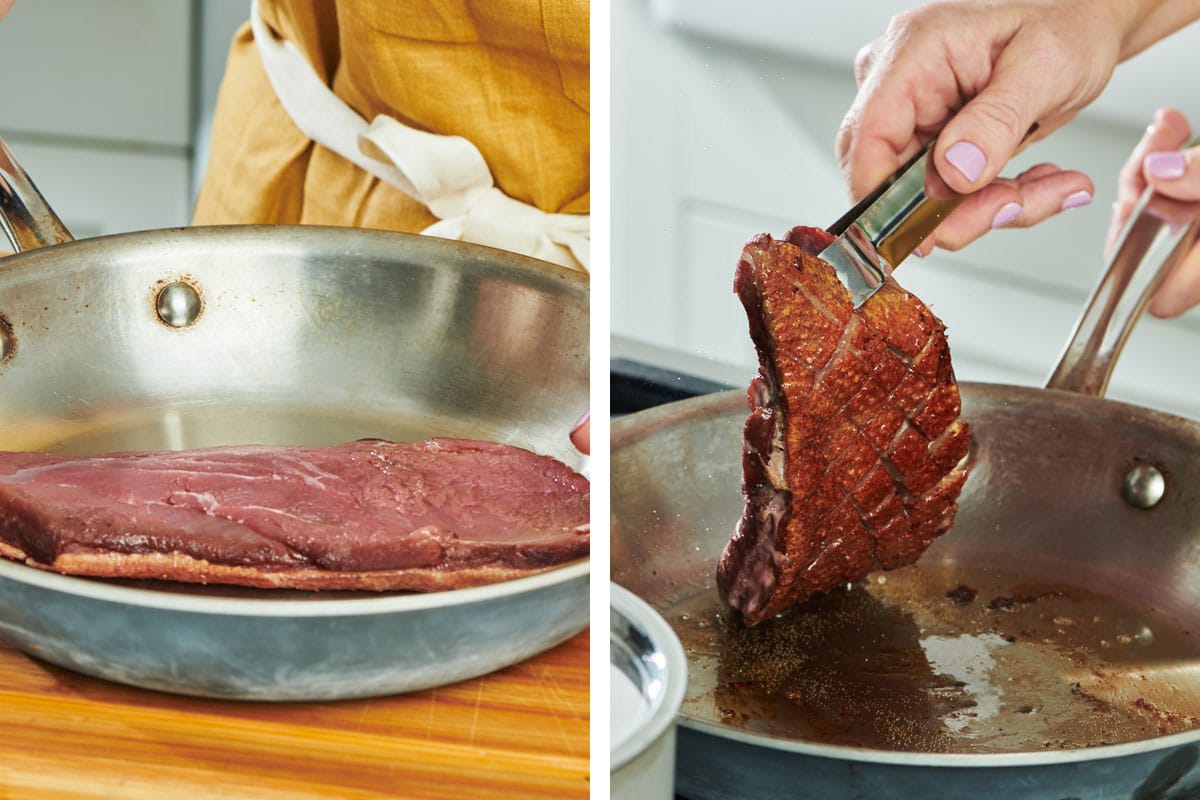
- Cook the other side: Flip the duck and continue to cook for about 3 to 4 minutes for medium-rare (an internal temperature of 130 degrees), or until the duck is cooked to your liking. Keep in mind that the duck will continue to cook a bit after it is removed from the heat.

- Let the duck rest: Remove the duck from the pan and let sit skin side up on a cutting board for 5 more minutes.
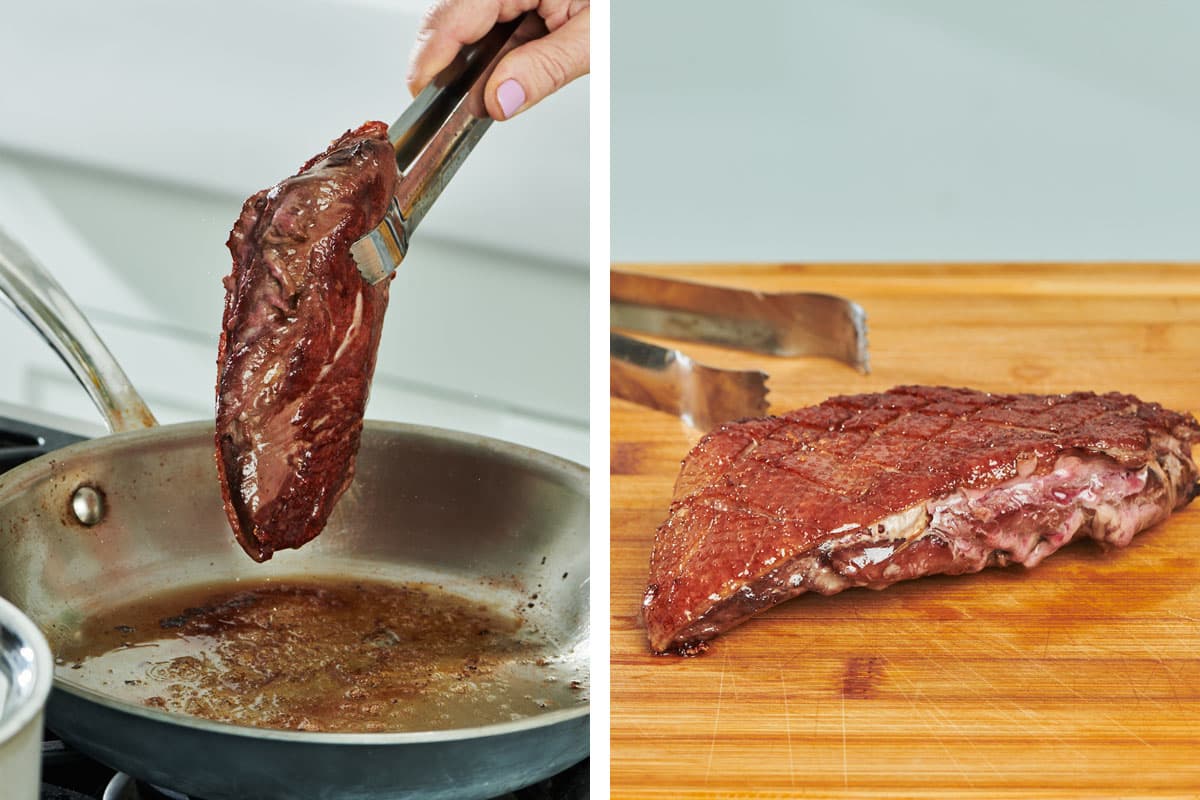
- Serve: You can serve the duck breasts whole, or slice each breast crosswise on the diagonal about 1/2 inch thick. Fan the slices out a bit on the plate, and serve.

Pro Tips for Cooking Duck Breasts
- According to The Cook’s Illustrated Complete Book of Poultry, cooking duck at a too-low temperature will prevent the skin from browning properly. The same is true of indirect heat; you need direct heat that builds from low to high to get the crispiest skin.
- Cook duck longer on the skin side, which allows the skin to get crispy. This extra cooking time on the skin side renders more fat, and the skin protects the meat from drying out.
- Start duck breasts in a cold pan. Raise the heat slowly to medium-high to render the fat. Pour off the accumulated released fat midway through the cooking.
- Once the fat cooks out, the skin will crisp up beautifully, and the meat will be tender and juicy. Duck is best cooked to medium-rare, and then thinly sliced, like a great steak.
- Let the duck breast rest for a few minutes before slicing and serving. Like most meat, you want to allow the duck to sit and reabsorb its juices while it reaches its perfect internal temperature.
- Duck can be served warm or at room temperature. Once any leftover duck is refrigerated, the skin will lose its crispness. You can re-crisp the skin by heating the breasts skin-side down in a pan over medium-high heat. Or, remove the skin, and just enjoy the leftover duck meat.
- Save the duck fat for roasting, using it instead of oil. Potatoes roasted in duck fat are particularly fantastic.
Variation
Crispy Skinned Duck with Sour Cherry Sauce: While the duck is resting, pour off the excess fat from the pan (save it to make roasted duck fat potatoes!). In the pan with just a film of duck fat, sauté 1 minced shallot for 2 minutes until softened. Add 1/2 cup sour cherry preserves (I like the Divina brand), 1 tablespoon of fresh lemon juice, and a sprig of fresh thyme leaves (optional). Bring to a gentle simmer. Spoon the sour cherry sauce over the sliced duck breast.

What to Serve With Duck Breast
More Kitchen Smarts
Pin this now to find it later
Pin It
How to Cook Duck Breast
Ingredients
- 2 boneless duck breasts (about 6 ounces each)
- Kosher salt and freshly ground black pepper (to taste)
Instructions
- Use a sharp knife to score the skin of each duck breast, with each cut about 1/2 inch apart, creating a diamond pattern. Do not cut through the fat into the flesh; stop once you’ve cut through the skin into the layer of fat beneath.
- Season the duck with salt and pepper on both sides. Place the duck skin side down into a cold skillet. Place the skillet over medium heat. Cook, without moving the duck breasts, until much of the fat has rendered out, and the skin is crispy and browned, about 10 to 12 minutes in all. After about 5 minutes, pour off the fat that has rendered into the pan. The breasts will shrink up a bit as they cook. Watch that the heat doesn’t get too high — you want the skin to brown slowly and consistently.
- Flip the duck and continue to cook for about 3 to 4 minutes for medium-rare (an internal temperature of 130 degrees), or until the duck is cooked to your liking. Keep in mind that the duck will continue to cook a bit after it is removed from the heat. Remove the duck from the pan and let sit skin side up on a plate or cutting board for 5 more minutes. You can serve the duck breasts whole, or slice each breast crosswise on the diagonal about 1/2 inch thick. Fan the slices out a bit on the plate, and serve.
Notes
- According to The Cook’s Illustrated Complete Book of Poultry, cooking duck at a too-low temperature will prevent the skin from browning properly. The same is true of indirect heat; you need direct heat that builds from low to high to get the crispiest skin.
- Cook duck longer on the skin side, which allows the skin to get crispy. This extra cooking time on the skin side renders more fat, and the skin protects the meat from drying out.
- Start duck breasts in a cold pan. Raise the heat slowly to medium-high to render the fat. Pour off the accumulated released fat midway through the cooking.
- Once the fat cooks out, the skin will crisp up beautifully, and the meat will be tender and juicy. Duck is best cooked to medium-rare, and then thinly sliced, like a great steak.
- Let the duck breast rest for a few minutes before slicing and serving. Like most meat, you want to allow the duck to sit and reabsorb its juices while it reaches its perfect internal temperature.
- Duck can be served warm or at room temperature. Once any leftover duck is refrigerated, the skin will lose its crispness. You can re-crisp the skin by heating the breasts skin-side down in a pan over medium-high heat. Or, remove the skin, and just enjoy the leftover duck meat.
- Save the duck fat for roasting, using it instead of oil. Potatoes roasted in duck fat are particularly fantastic.
